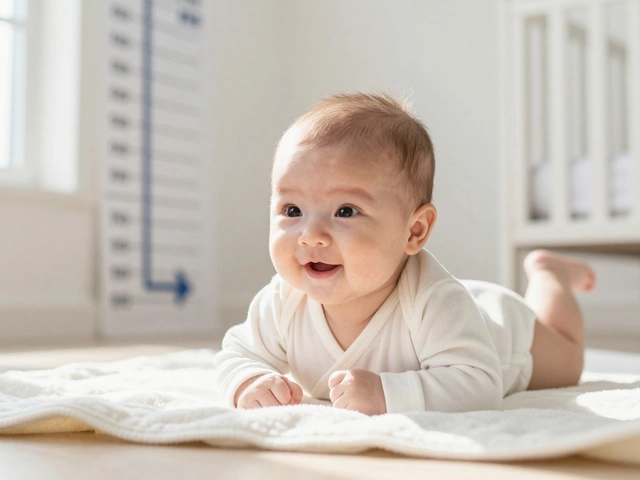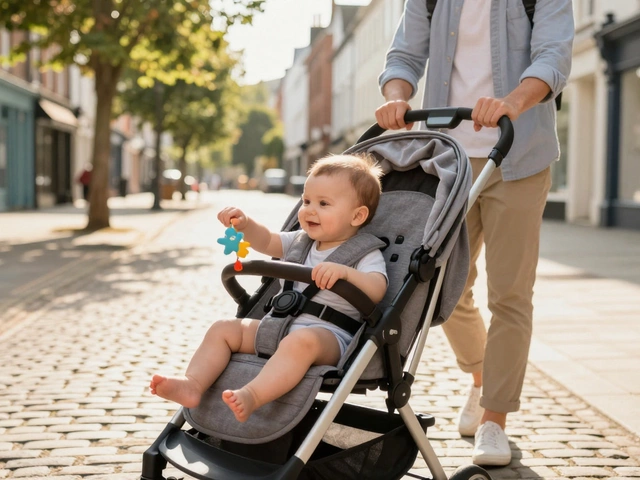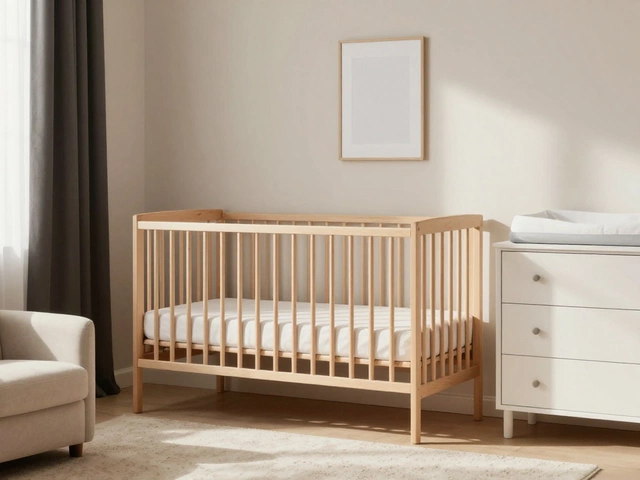
Ever notice how a bad backpack can make your shoulders ache after just ten minutes? It’s a hundred times more important with a baby carrier—your little one’s safety and comfort depend on getting the fit right.
The surprising thing? Most parents get tripped up by the smallest details, like where the baby’s knees point or how snug the straps are. A sloppy fit can strain your back or even leave baby slumped in a risky position.
So, what actually counts as good form? Think of it like this: your baby's bottom should be below their knees in an "M" shape, facing your chest close enough to kiss, with their airway always clear. Your back and shoulders should stay pretty relaxed and upright, not hunched or uneven.
Getting this basic setup right not only keeps your baby safe but also means you can run after your other kids, grab groceries, or just enjoy hands-free snuggles without fighting aches later. It's not about fancy brands—it's about knowing what to look for and making small adjustments as you go.
- Why Proper Form Matters
- Quick Anatomy of a Safe Carry
- Step-by-Step Carrier Fit Guide
- Common Mistakes and How to Fix Them
- Adapting Form as Baby Grows
- Tips for Everyday Comfort
Why Proper Form Matters
Getting the baby carrier position right isn’t just about comfort—it’s about your child’s basic safety and development. An improper fit can actually cut off a baby’s airway or increase risk for hip problems, especially in newborns. You might think carriers are foolproof, but even popular brands can be misused without clear guidance.
Studies back this up. According to the International Hip Dysplasia Institute, holding infants in a well-supported "M" (knees above bottom) shape helps their hip joints develop the way they're supposed to. Carriers that let legs dangle straight down can raise the risk of hip dysplasia, especially during those first six months when joints are still forming.
| Common Risk | Potential Issue |
|---|---|
| Chin on Chest | Airway may be blocked |
| Poor Hip Support | Higher risk of hip dysplasia |
| Loose Carrier | Slumping, possible falls |
| Incorrect Sizing | Back/shoulder pain for parent |
Safety checks are easy to do. If your baby's face is visible and kissable, they're already in a safer spot. When you hug them, they shouldn't pull away from your body—they should feel snug and well supported. Meanwhile, having the right structure helps you, too. If the carrier hurts, it’s probably not adjusted the right way, or it’s the wrong style for you.
Long-term, the right fit doesn’t just protect your baby’s body—it protects yours. Poor posture while carrying leads to back pain or tired shoulders in record time. And since most of us have to juggle a million other things (like chasing after energetic siblings), getting the fit right saves you a lot of hassle down the road.
Quick Anatomy of a Safe Carry
Before strapping in your little one, it’s smart to know what you’re aiming for. A safe baby carrier set-up is all about supporting your baby’s hips, spine, and airway, plus saving your own body from strain.
- Baby carrier seat: The baby's bum should sit deep in the carrier, with knees higher than the bum (that famous “M” shape). This is what most pediatricians recommend for healthy hip development and helps reduce the risk of hip dysplasia.
- Spine support: Baby’s back should remain in a natural curve, not forced flat or slouched. Newborns especially need their heads supported so their chin stays off the chest—think a two-finger space under the chin for free breathing.
- Chin up: Face should always be visible, with no fabric covering the nose or mouth. Tucking the chin leads to bad airflow, so check often.
- Close enough to kiss: This rule gets repeated everywhere for a reason. If you tilt your head, you should be able to kiss the top of your baby’s head without any trouble.
- Snug fit: The carrier should hold your baby tight against you, but not squeeze. If you lean forward, your baby shouldn't pull away from your body or slump.
Here’s a quick snapshot of what proper babywearing looks like, based on safety guidelines from the International Hip Dysplasia Institute and babywearing experts:
| Carry Feature | What To Check |
|---|---|
| Hip Position | Knees above bum, legs in “M” shape |
| Back Support | Natural spine curve, no slumping |
| Airway | Chin off chest, mouth/nose uncovered |
| Proximity | Close enough to kiss |
| Carrier Fit | No gapping or looseness against your chest |
Research actually shows that babies carried in the right position cry up to 43% less in general and 54% less in the evening hours. That’s not magic—it’s just proper form keeping everybody comfortable!
Step-by-Step Carrier Fit Guide
Nailing the fit on your baby carrier isn’t rocket science, but you do need to pay attention to a few main things. Tiny adjustments can seriously change how comfy both you and your baby feel.
- Start With the Right Size for Your Baby’s Age
Double-check if your carrier is made for newborns or bigger babies. Some need an infant insert for tiny ones. Read the label or check the weight range before you even begin. - Put on the Carrier Before Picking Up Your Baby
Set up the buckles, straps, or fabric first. Doing this ahead of time means you don’t get flustered holding a wriggling baby while trying to adjust everything. - Buckle Up Securely (But Not Too Tight)
Slide your arms through, fasten around your waist or shoulders, and pull the straps until the carrier feels snug. You should feel the carrier hug your body, but you still want to breathe easy and move your arms freely. - Get Your Baby Into Position
Lift your baby against your chest, guiding their legs so the knees are higher than their bottom, forming an “M” shape. Their back should be gently rounded, and their head turned to the side if they're very little. For older babies, make sure their arms are out if it’s more comfortable for them. - Check the Airway
This is key: Make sure your baby’s face is always visible and their nose and mouth aren’t covered by fabric or pressed into your chest. The rule is “close enough to kiss”—you should be able to tip your head down and gently kiss the top of your baby’s head without straining. - Make Final Tweaks
Look in a mirror (or get someone to check for you) to see the carrier sits even, isn’t leaning, and supports your baby. If you notice bunching, loose fabric, or discomfort in your shoulders or waist, try tightening or loosening straps a little at a time.
If you’re wearing a wrap, take extra time with the fabric, smoothing out wrinkles and making sure there’s even support from knee to knee. Don’t rush this—an even wrap saves you tons of back pain later.
Kids grow fast, so keep rechecking the fit every few weeks. What worked at two months can change when your baby packs on the rolls or gets taller.

Common Mistakes and How to Fix Them
You wouldn’t believe how many parents—myself included, in those early days—mess up the basics. It happens even if you've watched every YouTube video and read the manual twice. But don't stress. Fixes are usually quick once you know what to spot.
- Baby carrier worn too loose: If the carrier isn’t snug, baby slumps, which is tough on their hips and can block airflow. It should feel like a hug—secure, but not squishing. Use the "kiss test": baby should be close enough to kiss with a nod.
- Legs dangling straight down: If their knees aren’t above their hips in that classic "M" shape, their hips aren’t well-supported. Adjust the seat area so their thighs rest up and out.
- Face covered or chin tucked: This one's scary—if baby's nose or mouth is blocked, that’s a suffocation risk. Always check the fabric isn’t over the nose and the chin isn’t touching the chest. Two-finger gap under the chin keeps airways clear.
- Shoulder straps twisted or slipping: Twisted straps create weird pressure points and slipping ones don’t support. Smooth them out every time you put the carrier on and tighten as needed.
- Carrier sitting too low: If baby is riding near your belly button, it’s tough on your back. Raise the waistband so baby's head is at or just below your collarbones.
There was a study in 2022 that found 43% of parents new to carriers didn't position their baby's hips right on their first try. That sounds high, but it's fixable the moment you make a habit of checking.
| Mistake | Why It Matters | Quick Fix |
|---|---|---|
| Carrier Too Loose | Risk of slumping, blocked airway | Tighten all straps, do kiss test |
| Legs Dangling | Hip dysplasia risk | Make sure seat is knee-to-knee, adjust “M” shape |
| Face Covered | Breathing risk | Clear fabric, keep chin off chest |
| Twisted Straps | Uncomfortable, less support | Straighten straps every time |
| Carrier Too Low | Back strain | Raise waistband, baby high on chest |
Once you start checking these things each time, it takes less than a minute. I got into a routine after my second week with Sorrel. Soon it was muscle memory, and no more droopy baby or sore shoulders at the farmers' market.
Adapting Form as Baby Grows
Babies change so fast, and what works for your newborn in a baby carrier might not fit at all once they’re six months old—or even six weeks. The main thing to remember: the way you use your carrier needs to grow along with your kid.
When your baby is brand new, their neck muscles aren’t strong enough to support their head. They need a carrier with good head and neck support, keeping their chin off their chest to protect their airway. You also have to watch their hips. The International Hip Dysplasia Institute says carriers that keep baby’s knees higher than their bum (think "M" shape) are best for healthy hip development—especially in the first six months.
Once your baby gets more wiggly and starts holding up their head, you can loosen things up a bit. Suddenly, baby can face out in some carriers (usually around five or six months, depending on brand and pediatrician advice), but you still need that deep seat and support up to the mid-back. Babies love the new view, but don’t let baby nap facing out—their head might roll forward and block their breathing.
As your child hits toddler status, you'll notice they want their arms free or a hip carry to see around better. You might adjust straps for your comfort, too, since bigger kids are heavier. Most structured carriers are rated to hold kids up to 40 pounds. If it feels heavy, you’re not alone—lots of parents swap to hip or backpack style carries as toddlers get squirmier and taller.
| Age/Stage | Key Form Adjustments | Common Carrier Type |
|---|---|---|
| 0-4 months | Head and neck support, high & snug, knees above hips | Wraps, slings, soft-structured in newborn mode |
| 4-7 months | Mid-back support, possible facing-out, monitor airways | Soft-structured, some Mei Tai styles |
| 8+ months | Hip or back carries, adjust straps for comfort | Soft-structured, hiking packs, ring slings (hip) |
- Always check carrier instructions for age and weight updates—they change more often than you’d think!
- If baby cries or squirms in a new position, pause and see if an adjustment (seat height or strap tightness) helps.
- Red marks on baby’s legs or your shoulders are a sign to check your fit.
- Want to make it easier? Try practicing carrier changes at home before you go anywhere.
Lots of parents start with a stretchy wrap, then move to structured carriers as their baby hits milestones—no shame in owning more than one type. Just follow those fit basics as your little one grows, and both of you will stay happier.
Tips for Everyday Comfort
Carrying your baby should feel good for both you and your little one. Here’s what really helps take the daily grind off your shoulders—literally.
- baby carrier fit means more than just buckling in. The waistband should sit high and snug on your hips, not your waist. That’s where your body is strongest, so you’re less likely to get backaches.
- Keep the straps wide and flat on your shoulders, kind of like how you’d wear a backpack. Narrow, twisted straps can dig in and pinch after just a few minutes, especially on hectic days.
- Don’t be afraid to make tiny adjustments every time you put it on. One quick tug on a loose strap or a small shift can save you hours of discomfort.
- If you’re out for longer periods, break up the carry with standing and sitting to give your body little breathers. Even a one-minute pause makes a difference.
- Dressing your baby in light layers is way more practical. Carriers act like an extra layer, so you want to avoid overheating. (A 2023 survey from Babywearing International found more than 40% of parents said their babies got sweaty if overdressed in a carrier.)
| Issue | Fix |
|---|---|
| Shoulder pain | Widen straps, check even weight distribution |
| Back discomfort | Raise waistband, tighten all straps slightly |
| Baby seems squished | Check "M" shape, loosen leg area if needed |
| Hot or sweaty baby | Use breathable fabrics and light layers |
A few extra hacks: If you’ve got long hair, tie it up to avoid tangles with buckles. Use the tiny pocket on most carriers for snacks or wipes, not your keys—sharp objects can dig into both you and baby. And trust your gut: if something feels off, re-check that everything’s lined up, even if it’s just for a grocery run.






